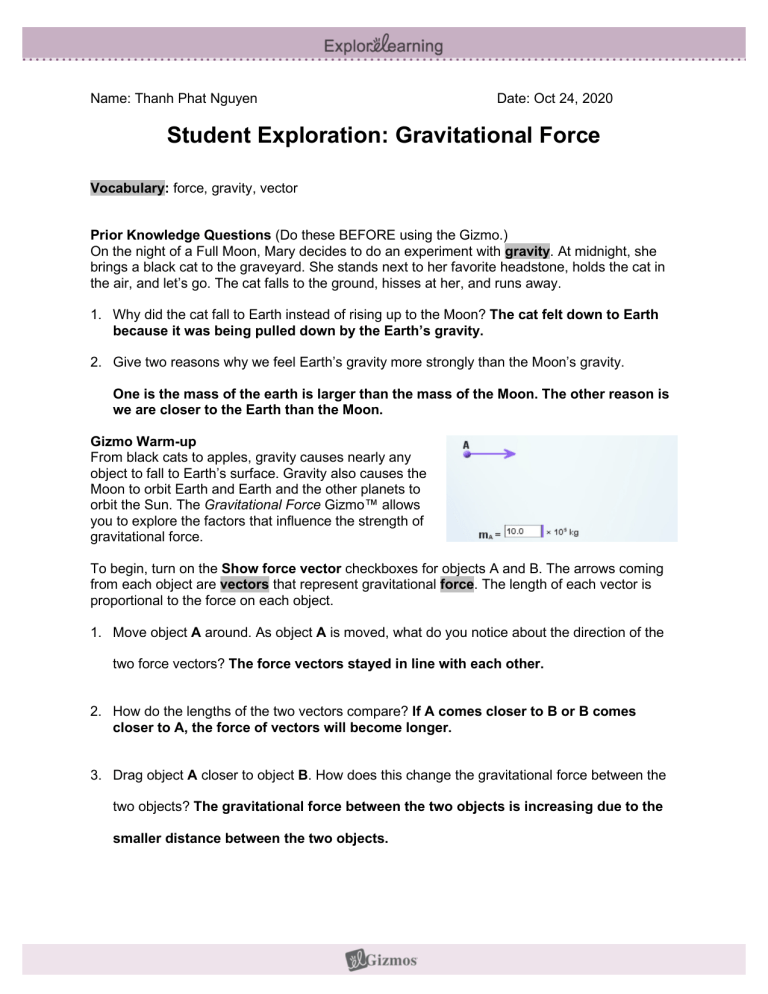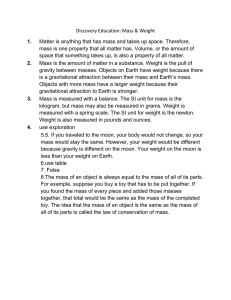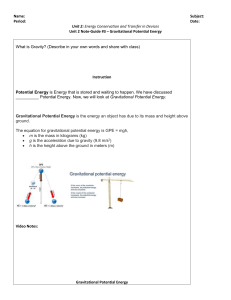
Name: Thanh Phat Nguyen Date: Oct 24, 2020 Student Exploration: Gravitational Force Vocabulary: force, gravity, vector Prior Knowledge Questions (Do these BEFORE using the Gizmo.) On the night of a Full Moon, Mary decides to do an experiment with gravity. At midnight, she brings a black cat to the graveyard. She stands next to her favorite headstone, holds the cat in the air, and let’s go. The cat falls to the ground, hisses at her, and runs away. 1. Why did the cat fall to Earth instead of rising up to the Moon? The cat felt down to Earth because it was being pulled down by the Earth’s gravity. 2. Give two reasons why we feel Earth’s gravity more strongly than the Moon’s gravity. One is the mass of the earth is larger than the mass of the Moon. The other reason is we are closer to the Earth than the Moon. Gizmo Warm-up From black cats to apples, gravity causes nearly any object to fall to Earth’s surface. Gravity also causes the Moon to orbit Earth and Earth and the other planets to orbit the Sun. The Gravitational Force Gizmo™ allows you to explore the factors that influence the strength of gravitational force. To begin, turn on the Show force vector checkboxes for objects A and B. The arrows coming from each object are vectors that represent gravitational force. The length of each vector is proportional to the force on each object. 1. Move object A around. As object A is moved, what do you notice about the direction of the two force vectors? The force vectors stayed in line with each other. 2. How do the lengths of the two vectors compare? If A comes closer to B or B comes closer to A, the force of vectors will become longer. 3. Drag object A closer to object B. How does this change the gravitational force between the two objects? The gravitational force between the two objects is increasing due to the smaller distance between the two objects. Activity A: Gravity and mass Get the Gizmo ready: • Turn on Show vector notation for each object. • Check that each object’s mass (mA and mB) is set to 10.0 × 105 kg. Question: How does mass affect the strength of gravitational force? 1. Form hypothesis: How do you think the masses of objects A and B will affect the strength of the gravitational force between them? The larger the mass, the stronger the gravitational forces between the objects. 2. Predict: How do you think the gravitational force between two objects will change if the mass of each object is doubled? The gravitational force between two objects will be double if the mass of each object is doubled. 3. Measure: Turn on Show grid. Place object A on the x axis at -20 and object B on the x axis at 20. The force on object A is now 0.0417i + 0j N. That means that the force is 0.0417 newtons in the x direction (east) and 0.0 newtons in the y direction (north). A. What is the magnitude of the force on object A? |FA| = 0.0417 N B. What is the magnitude of the force on object B? |FB| = 0.0417 N 4. Gather data: You can change the mass of each object by clicking in the text boxes. For each mass combination listed in the table below, write magnitude of the force on object A. Leave the last two columns of the table blank for now. mA (kg) mB (kg) |FA| (N) Force factor mA × mB (kg2) 10.0 × 105 kg 10.0 × 105 kg 0.0417 N 1 1.00 x 10 12 10.0 × 105 kg 20.0 × 105 kg 0.0834 N 2 2.00 x 10 12 20.0 × 105 kg 20.0 × 105 kg 0.1667 N 4 4.00 x 10 12 20.0 × 105 kg 30.0 × 105 kg 0.2501 N 6 6.00 x 10 12 5. Calculate: To determine how much the force is multiplied, divide each force by the first value, 0.0417 N. Round each value the nearest whole number and record in the “Force factor” column. Next, calculate the product of each pair of masses. Fill in these values in the last column. Compare these numbers to the “Force factor” numbers. (Activity A continued on next page) Activity A (continued from previous page) 6. Analyze: How much does the force increase if each mass is doubled? The force quadruples if each mass is doubled. 7. Analyze: How do the force factors compare to the products of the masses? The force factors are equal to the amount that the product of the masses is multiplied by. 8. Apply: What would you expect the force to be if the mass of object A was 50.0 × 105 kg and the mass of object B was 40.0 × 105 kg? 0.8337 N Check your answer with the Gizmo. 9. Draw conclusions: How do the masses of objects affect the strength of gravitational force? The greater the masses of the objects, the stronger the gravitational forces are. 10. Summarize: Fill in the blank: The gravitational force between two objects is proportional to the product of the masses of the objects. 11. Apply: Suppose an elephant has a mass of 1,800 kg and a person has a mass of 75 kg. If the strength of gravitational force on the person was 735 N, what would be the gravitational force on the elephant? (Assume both the person and elephant are on Earth’s surface.) The result is 17640 N on the elephant. Show your work: Fe = mg = 1800 x 9.8 = 17640 (N) Activity B: Gravity and distance Get the Gizmo ready: • Turn on Show distance. • Set mA and mB to 10.0 × 105 kg. Question: How does distance affect the strength of gravitational force? 1. Form hypothesis: How do you think the distance between objects A and B will affect the strength of the gravitational force between them? As both objects A and B get closer, the strength of the gravitational force between them will increase. 2. Predict: How do you think the gravitational force between two objects will change if the distance between the objects is doubled? The gravitational force between the objects will be a fourth if the distance between the objects is doubled. 3. Measure: Place object A on the x axis at -5 and object B on the x axis at 5. A. What is the distance between the two objects? 10 meters B. What is the magnitude of the force on object A? |FA| = 0.667 N 4. Gather data: For each set of locations listed below, record the distance and the force on object A. Leave the last two columns blank for now. Object A Object B Distance (m) |FA| (N) Force factor 1 Distance2 (-5, 0) (5, 0) 10.00 m 0.667 N 1 1/100 m2 (-10, 0) (10, 0) 20.00 m 0.1667 N 1/4 1/400 m2 (-15, 0) (15, 0) 30.00 m 0.0741 N 1/9 1/900 m2 (-20, 0) (20, 0) 40.00 m 0.0417 N 1/16 1/1600 m2 5. Interpret: How does increasing the distance affect the force? As the distance increases, the force will be decreased. 6. Calculate: To calculate the force factor, divide each force by the original force (0.667 N). Write each force factor with three significant digits. Next, calculate the reciprocal of the square of each distance and fill in the last column of the table. Write each of these values with three significant digits as well. (The unit of 1/distance 2 is square meters, or m2.) (Activity B continued on next page) Activity B (continued from previous page) 7. Analyze: Compare the force factors to the 1/distance2 values in your table. What is the relationship between these values? The force factors are 100 times greater than the 1/distance2 value. 8. Apply: What would you expect the force to be if the distance was 50 meters? 0.0267 N Use the Gizmo to check your answer. 9. Make a rule: Based on the measured force between objects that are 10 meters apart, how can you find the force between objects that are any distance apart? The distance squared multiply it by the gravity constant G. 10. Summarize: Fill in the blanks: The gravitational force between two objects is proportional to the inverse of the distance squared 11. Challenge: In activity A, you found that the gravitational force between two objects is proportional to the product of their masses. Combine that with what you have learned in this activity to complete the universal formula for the force of gravity below. (Hint: In the equation, G is a constant.) Check your answer with your teacher. FGravity = G mass mas mass mass • Distance2 12. On your own: Use the Gizmo to find the value of G in the formula above. List the value and describe how you found it below. The units of G are newton · meter2 ÷ kilograms2, or N·m2/kg2. Check your answer with your teacher. G = 6.67 x 10 -11 N * m2/kg Show your work: Given: D = 50 m M1 = 10 x 105 kg M2 = 10 x 105 kg F = 0.0267 N G = (F x d2) / (m1 x m2) = (0.0267 x 502) / (10.0 x 105 x 10.0 x 105) = 6.675 x 10-11 (N * m2/kg)






